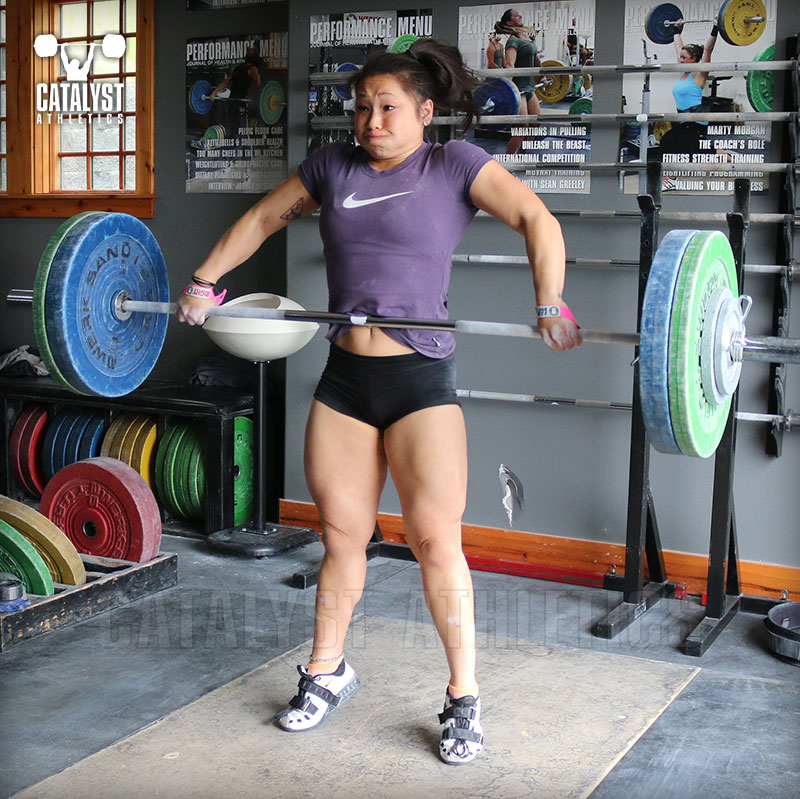Ask Greg: Issue 196

Isaac Asks: Do you landmark heights where the bar will be pulled to? Example being the 3rd pull of a Snatch. Do you get athletes to pull the bar to specific height (chest height) through the third pull with the forefoot still being (somewhat) connected to the floor, before the athlete sits into their receiving height as the bar continues moving into the overhead position. Would this differ from power to classic lifts- being, that you rather emphasize on the bar being pulled higher intentionally or the bar and body moving faster from the 2nd & 3rd pull, turnover and receiving position? Is there a context for either, context for both?
Greg Says: My potentially disappointing answer is that I never lay out height targets for athletes except occasionally in fairly vague terms more as a cue than a precise goal. In other words, if a lifter is cutting the pull short, I’ll encourage them to pull longer/higher, and to that end I may tell them something like, “Keeping pushing through the floor until the bar is at your ribs.” But again, this is not necessarily a landmark that accurately corresponds with a precise height, but rather just a way for the athlete to think of the timing.
Ultimately the movement is (or should be) too quick to really assess the position of the bar at that point and make a decision about it. So there’s always a risk that in instructing a lifter to pull to a specific position, they’re going to slow themselves down by thinking their way through the lift and lose the tempo necessary to actually make it. Even if they could quickly enough recognize the bar reaching that point, they won’t be able to then react and pull under quickly enough.
With regard to power vs full lifts, yes the bar needs to be pulled higher for power lifts, but this should also happen pretty naturally as the weights are lighter and the athlete is trying to put as much power into the pull as possible. The motion and timing of the pull itself shouldn’t need to be adjusted consciously.
One exception would be a snatch or clean with no jump, in which the goal is to exaggerate the pull height significantly, i.e. to continue pulling the bar up with an extended body much longer than you would in a snatch or clean (or the power variations). In that case, I’ll usually tell an athlete to pull the bar into a high-pull position before moving under, knowing that at least with heavier weights, it won’t actually happen, but it will help them continue the pull long enough.
Greg Says: My potentially disappointing answer is that I never lay out height targets for athletes except occasionally in fairly vague terms more as a cue than a precise goal. In other words, if a lifter is cutting the pull short, I’ll encourage them to pull longer/higher, and to that end I may tell them something like, “Keeping pushing through the floor until the bar is at your ribs.” But again, this is not necessarily a landmark that accurately corresponds with a precise height, but rather just a way for the athlete to think of the timing.
Ultimately the movement is (or should be) too quick to really assess the position of the bar at that point and make a decision about it. So there’s always a risk that in instructing a lifter to pull to a specific position, they’re going to slow themselves down by thinking their way through the lift and lose the tempo necessary to actually make it. Even if they could quickly enough recognize the bar reaching that point, they won’t be able to then react and pull under quickly enough.
With regard to power vs full lifts, yes the bar needs to be pulled higher for power lifts, but this should also happen pretty naturally as the weights are lighter and the athlete is trying to put as much power into the pull as possible. The motion and timing of the pull itself shouldn’t need to be adjusted consciously.
One exception would be a snatch or clean with no jump, in which the goal is to exaggerate the pull height significantly, i.e. to continue pulling the bar up with an extended body much longer than you would in a snatch or clean (or the power variations). In that case, I’ll usually tell an athlete to pull the bar into a high-pull position before moving under, knowing that at least with heavier weights, it won’t actually happen, but it will help them continue the pull long enough.
| Greg Everett is the owner of Catalyst Athletics, publisher of The Performance Menu Journal and author of Olympic Weightlifting: A Complete Guide for Athletes & Coaches, Olympic Weightlifting for Sports, and The Portable Greg Everett, and is the writer, director, producer, editor, etc of the independent documentary American Weightlifting. Follow him on Facebook here. |
Search Articles
Article Categories
Sort by Author
Sort by Issue & Date
Article Categories
Sort by Author
Sort by Issue & Date

